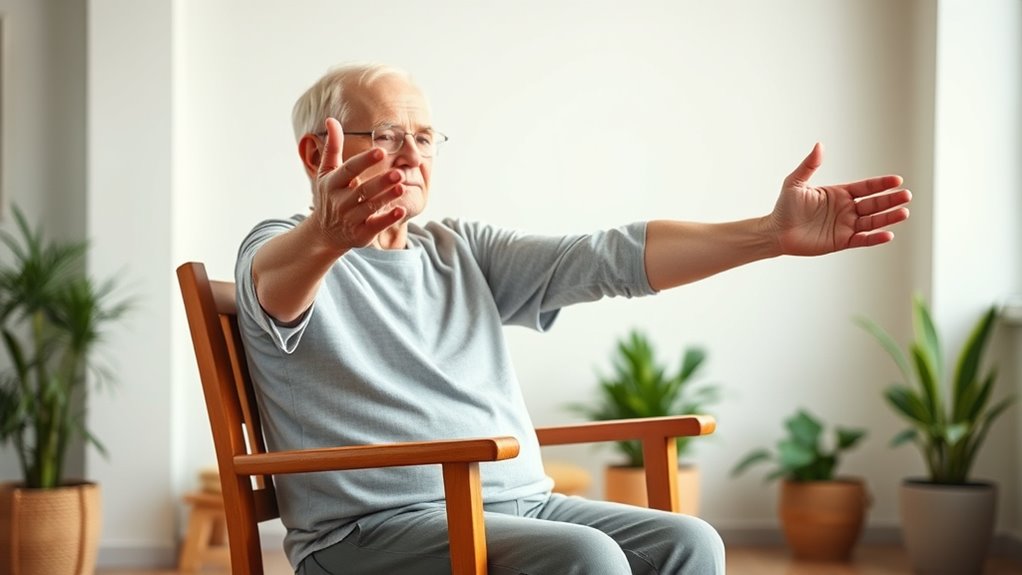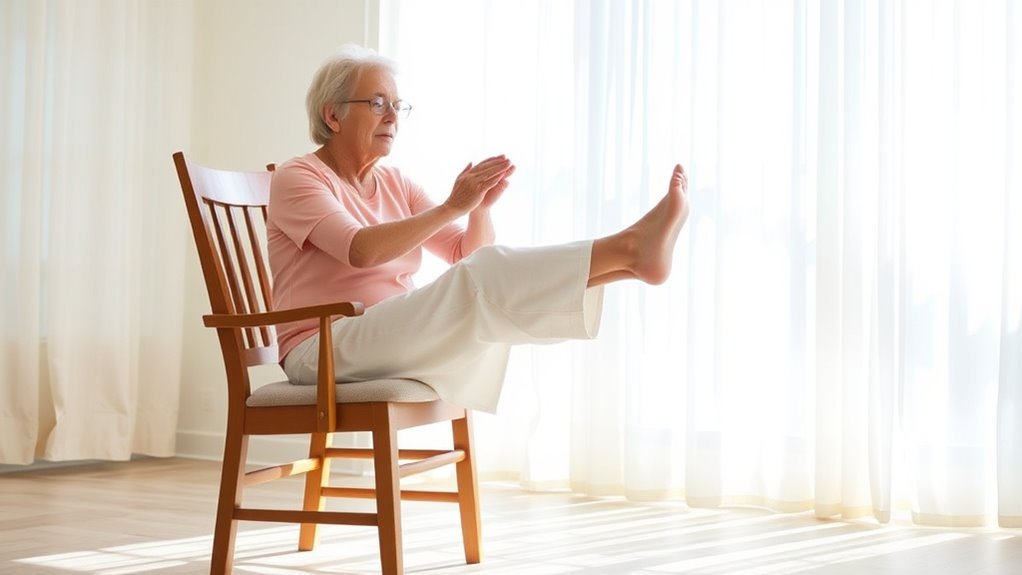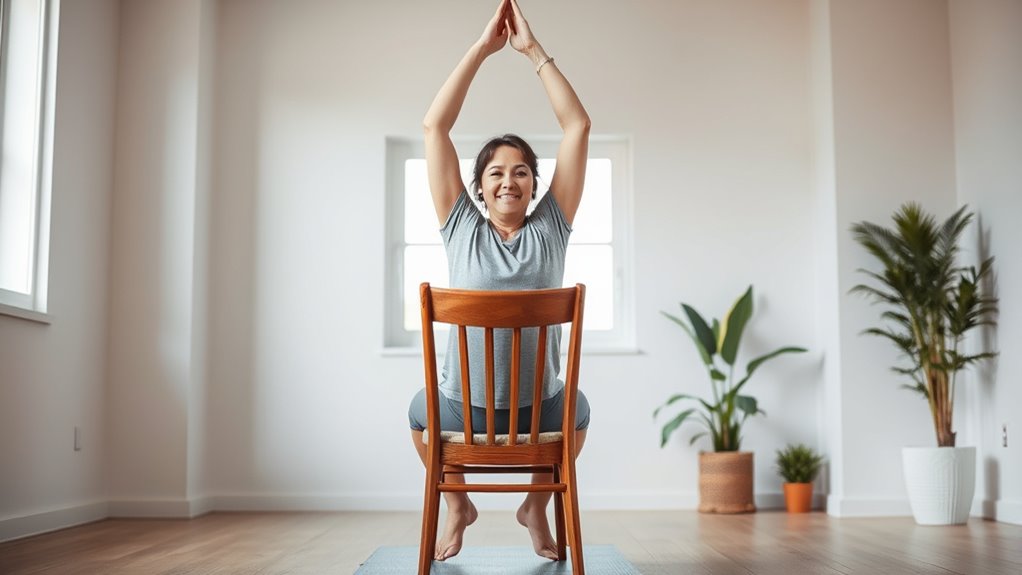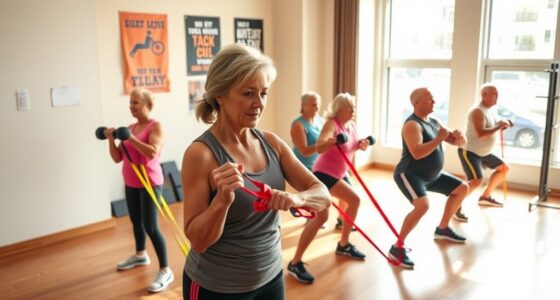A chair yoga sequence for limited mobility includes gentle stretches, twists, and movements you can do seated to improve flexibility, reduce tension, and support joint health. Focus on relaxing your neck, shoulders, and spine with slow movements, while incorporating breathing and mindfulness for mental clarity. Leg lifts, ankle circles, and arm stretches are easy to incorporate. Keep posture in check and adjust your chair for comfort. Continue exploring for more tips to optimize your practice and benefits.
Key Takeaways
- Focus on gentle, seated stretches to improve flexibility and reduce tension for limited mobility.
- Incorporate breathing and mindfulness techniques to enhance mental clarity and relaxation.
- Ensure proper chair setup for safety, comfort, and optimal posture during exercises.
- Include leg lifts, ankle circles, and arm movements to strengthen muscles without strain.
- Promote long-term benefits like joint stability and improved daily activity through consistent practice.
Preparing Your Space and Seated Posture

To get the most benefit from chair yoga, start by creating a calm, clutter-free space where you can sit comfortably. Make sure your chair is sturdy and stable, with chair adjustments made to fit your body. Adjust the seat height so your feet rest flat on the floor, and your knees are at a 90-degree angle. Sit with your back straight, but relaxed, ensuring your hips are supported. Safety considerations are key; avoid chairs that wobble or lack proper back support. Clear the area of any obstacles to prevent falls or injuries. Taking these steps guarantees your seated posture is correct and safe, allowing you to focus on the practice without distraction or risk. Proper setup maximizes comfort and helps prevent strain. Additionally, paying attention to chair stability can help prevent accidents during your practice. Incorporating awareness of your attention during setup can further enhance your focus and safety throughout your seated yoga session. Being mindful of body alignment can also contribute to a more effective and comfortable practice. Ensuring correct posture alignment can prevent discomfort and improve the benefits of your yoga session.
Neck and Shoulder Relaxation Exercises

Neck and shoulder relaxation exercises help release tension accumulated from daily activities and improve overall mobility. To start, gently tilt your head to one side, bringing your ear toward your shoulder, and hold for a few breaths. Switch sides to stretch neck muscles and reduce neck tension. Next, perform shoulder rolls, lifting your shoulders toward your ears and rolling them back and down. This shoulder stretch relieves tightness and loosens stiff muscles. You can also clasp your hands behind your head and gently press your elbows back to open the chest and relax the shoulders. Throughout these exercises, focus on slow, deliberate movements to enhance relaxation. Incorporating proper brewing techniques into your routine can help maintain healthy hair and scalp while performing these stretches. Regular practice helps reduce stress, eases neck tension, and promotes better posture, making daily activities more comfortable.
Gentle Spinal Twists and Side Stretching

After releasing tension in your neck and shoulders, gentle spinal twists and side stretches can help improve spinal mobility and enhance overall flexibility. These movements promote better spinal alignment and ease stiffness. To perform them safely: 1. Sit tall with feet flat on the floor, inhale, and gently twist your torso to one side, holding for a few breaths. 2. As you exhale, deepen the twist, ensuring your shoulders stay relaxed. 3. For side bending, reach one arm overhead and lean gently to the opposite side, feeling the stretch along your side body. These gentle twists and side stretches encourage healthy spinal alignment and increase flexibility, making daily movements easier and more comfortable. Always move within your comfort zone and avoid any painful sensations. Incorporating mindful breathing can also support relaxation and improve spinal health.
Arm and Wrist Movements for Flexibility

Start incorporating gentle arm stretches to loosen up your muscles, and focus on slow, controlled movements. Wrist mobility exercises can help improve flexibility and reduce stiffness, making daily tasks easier. Incorporating pressure relief techniques can further enhance comfort and prevent strain during these exercises. Engaging in mindful practice can also support creative thinking and overall well-being over time. By dedicating a few moments to these movements, you’ll enhance overall arm and wrist comfort. Additionally, practicing muscle flexibility can support better joint function and reduce discomfort over time.
Gentle Arm Stretches
Gentle arm stretches are an effective way to improve flexibility and relieve tension in your arms and wrists. When practicing these stretches, focus on maintaining good chair ergonomics to prevent strain and support your posture. Incorporate seated meditation into your routine to enhance relaxation and mindfulness. Using proper projection techniques can also help you maintain correct alignment and avoid discomfort during your practice. Incorporating glycolic acid benefits into your skincare routine can further support healthy skin, especially if you experience dryness or uneven texture. To get started: 1. Extend one arm forward, palm up, and gently pull your fingers back with your opposite hand. 2. Roll your wrists slowly in circles to increase joint mobility. 3. Cross one arm over your chest, using your other arm to gently press it closer.
These simple movements help loosen tight muscles, improve circulation, and prepare your arms for more advanced stretches. Remember to breathe deeply and stay comfortable throughout your practice.
Wrist Mobility Exercises
Wrist mobility exercises are a simple yet effective way to enhance flexibility and prevent strain in your wrists and hands. Regular movements can improve wrist strengthening and reduce stiffness. Start by gently rotating your wrists clockwise and counterclockwise, then stretch your fingers wide. Incorporate hand massage by using your opposite hand to gently knead your palms and fingers, promoting circulation. These exercises help maintain joint health and ease discomfort from limited mobility. Consistency is key, so perform these movements daily for best results. Additionally, proper air quality can support overall health and comfort during your exercises, especially since environmental factors can influence joint health and recovery. Using an air purifier with HEPA filters can reduce airborne irritants and allergens that may exacerbate inflammation or discomfort.
Leg Lifts and Ankle Circles

Leg lifts and ankle circles are effective moves to improve your lower body strength and enhance ankle flexibility. These exercises support ankle strengthening and promote better leg extension, which can help with mobility. To get the most benefit, focus on these key points:
- Lift one leg slowly, keeping your knee straight, to engage leg muscles and improve strength.
- Perform ankle circles in both directions to increase flexibility and circulation.
- Repeat each movement 8-10 times per leg to build endurance and mobility.
- Incorporating these exercises into your routine can also help reduce the risk of remote work burnout by promoting movement and circulation. Additionally, these exercises can support joint health by maintaining mobility and reducing stiffness.
- Consistent practice can also enhance muscle activation, leading to improved stability and support during daily activities.
These simple actions can be done comfortably from your chair, making them ideal for limited mobility. Regular practice helps maintain joint health and supports overall leg function, making daily activities easier.
Breathing and Mindfulness Practices

Incorporating breathing and mindfulness practices into your chair yoga routine can substantially enhance relaxation and mental clarity. Focus on simple meditation techniques like deep belly breaths or slow inhalations and exhalations to center your mind. These practices help reduce stress by calming your nervous system and promoting present-moment awareness. As you sit comfortably, take a few deep breaths, inhaling through your nose and exhaling gently through your mouth. Pay attention to how your breath feels, letting go of tension with each exhale. Regularly practicing mindfulness during your sessions can improve your ability to manage stress outside of yoga, creating a sense of calm and balance throughout your day. Optimal angles can also influence your posture and comfort during practice, making your sessions more effective and restorative. Additionally, mindful breathing can support stress reduction by activating your parasympathetic nervous system, which promotes relaxation and recovery. Incorporating recurring patterns in your awareness can deepen your connection with these techniques and enhance their benefits. Practicing mindfulness can also enhance your overall mental well-being and focus.
Frequently Asked Questions
Can Chair Yoga Be Effective for Chronic Pain Management?
You might wonder if chair yoga can help with chronic pain management. The answer is yes—chair yoga offers numerous benefits, including improved flexibility, reduced muscle tension, and enhanced circulation. These chair yoga benefits can lead to effective chronic pain relief, especially when regular practice is maintained. By incorporating gentle movements, you support your body and potentially lessen discomfort, making it a practical option for managing ongoing pain.
How Often Should I Practice Chair Yoga for Best Results?
Ever wondered how often you should practice chair yoga for the best results? The key is maintaining frequency consistency—aim for daily sessions or at least 3-4 times a week. Regular practice helps improve flexibility, reduce pain, and build strength over time. Stick to a routine that fits your schedule, listen to your body, and you’ll notice progress. Consistency truly makes all the difference in achieving your health goals.
Are There Specific Chair Modifications for Severe Mobility Limitations?
For severe mobility limitations, you should consider specific chair modifications to guarantee safety and effectiveness. Use chairs with sturdy armrests for better support during seated stretching, and opt for adjustable height chairs to accommodate your needs. Adaptive modifications, like removing wheels or adding cushions, can improve stability. These adjustments help you perform seated stretching comfortably, making your chair yoga practice safer and more accessible.
Can Chair Yoga Help Improve Mental Health and Mood?
This question hits the nail on the head—yes, chair yoga can dramatically boost your mental health and mood, like a sunrise after a long night. By practicing mindfulness and gentle movements, you actively nurture your emotional well-being. Regular chair yoga sessions help reduce stress, improve mood, and foster a sense of calm, making it a powerful tool for emotional stability. You’ll find yourself feeling more centered and resilient every day.
Is Chair Yoga Safe for Individuals With Cardiovascular Issues?
You might wonder if chair yoga is safe for those with cardiovascular issues. Generally, it can be beneficial for heart health and managing blood pressure, but you should consult your doctor first. Gentle movements can improve circulation and reduce stress, supporting your heart. Just guarantee you avoid strenuous poses and listen to your body. With proper guidance, chair yoga can be a safe addition to your wellness routine.
Conclusion
By incorporating these gentle chair yoga moves into your routine, you’ll find it easier to stay active and comfortable throughout the day. Remember, Rome wasn’t built in a day, so be patient with yourself and celebrate small victories along the way. Consistency is key, and with a little effort, you’ll notice improvements in your mobility and overall well-being. Keep moving at your own pace — each step counts toward a healthier, happier you.










